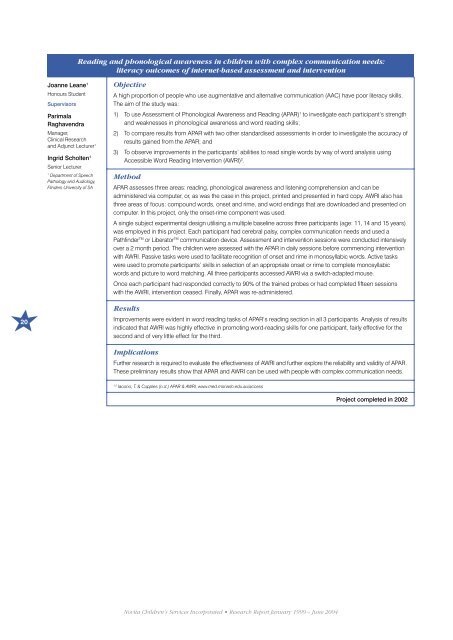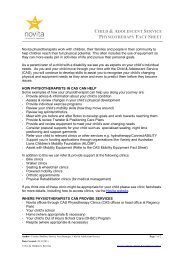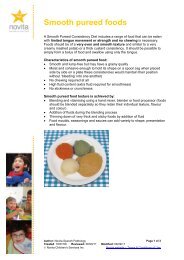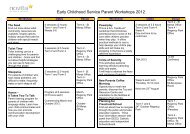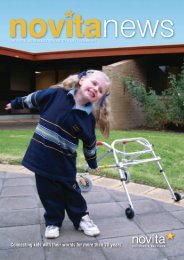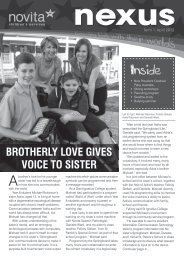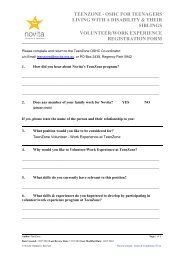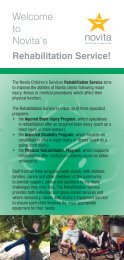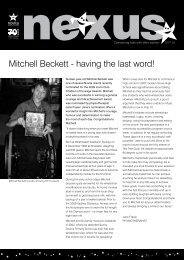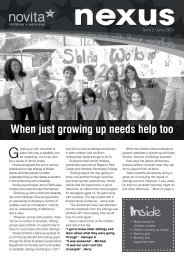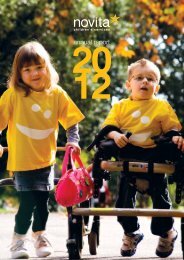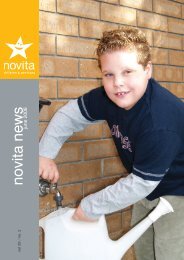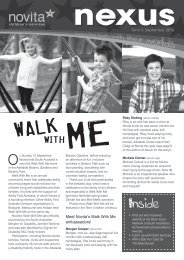Novita Research Report January 1999 - Novita Children's Services
Novita Research Report January 1999 - Novita Children's Services
Novita Research Report January 1999 - Novita Children's Services
You also want an ePaper? Increase the reach of your titles
YUMPU automatically turns print PDFs into web optimized ePapers that Google loves.
Reading and phonological awareness in children with complex communication needs:<br />
literacy outcomes of internet-based assessment and intervention<br />
Joanne Leane 1<br />
Honours Student<br />
Supervisors<br />
Parimala<br />
Raghavendra<br />
Manager,<br />
Clinical <strong>Research</strong><br />
and Adjunct Lecturer 1<br />
Ingrid Scholten 1<br />
Senior Lecturer<br />
1<br />
Department of Speech<br />
Pathology and Audiology,<br />
Flinders University of SA<br />
Objective<br />
A high proportion of people who use augmentative and alternative communication (AAC) have poor literacy skills.<br />
The aim of the study was:<br />
1) To use Assessment of Phonological Awareness and Reading (APAR) 1 to investigate each participant’s strength<br />
and weaknesses in phonological awareness and word reading skills;<br />
2) To compare results from APAR with two other standardised assessments in order to investigate the accuracy of<br />
results gained from the APAR; and<br />
3) To observe improvements in the participants’ abilities to read single words by way of word analysis using<br />
Accessible Word Reading Intervention (AWRI) 2 .<br />
Method<br />
APAR assesses three areas: reading, phonological awareness and listening comprehension and can be<br />
administered via computer, or, as was the case in this project, printed and presented in hard copy. AWRI also has<br />
three areas of focus: compound words, onset and rime, and word endings that are downloaded and presented on<br />
computer. In this project, only the onset-rime component was used.<br />
A single subject experimental design utilising a multiple baseline across three participants (age: 11, 14 and 15 years)<br />
was employed in this project. Each participant had cerebral palsy, complex communication needs and used a<br />
Pathfinder TM or Liberator TM communication device. Assessment and intervention sessions were conducted intensively<br />
over a 2 month period. The children were assessed with the APAR in daily sessions before commencing intervention<br />
with AWRI. Passive tasks were used to facilitate recognition of onset and rime in monosyllabic words. Active tasks<br />
were used to promote participants’ skills in selection of an appropriate onset or rime to complete monosyllabic<br />
words and picture to word matching. All three participants accessed AWRI via a switch-adapted mouse.<br />
Once each participant had responded correctly to 90% of the trained probes or had completed fifteen sessions<br />
with the AWRI, intervention ceased. Finally, APAR was re-administered.<br />
20<br />
Results<br />
Improvements were evident in word reading tasks of APAR’s reading section in all 3 participants. Analysis of results<br />
indicated that AWRI was highly effective in promoting word-reading skills for one participant, fairly effective for the<br />
second and of very little effect for the third.<br />
Implications<br />
Further research is required to evaluate the effectiveness of AWRI and further explore the reliability and validity of APAR.<br />
These preliminary results show that APAR and AWRI can be used with people with complex communication needs.<br />
1,2<br />
Iacono, T. & Cupples (n.d.) APAR & AWRI, www.med.monash.edu.au/access<br />
Project completed in 2002<br />
<strong>Novita</strong> Children’s <strong>Services</strong> Incorporated • <strong>Research</strong> <strong>Report</strong> <strong>January</strong> <strong>1999</strong> – June 2004


